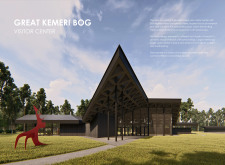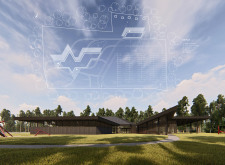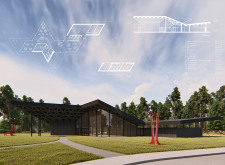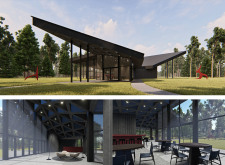5 key facts about this project
The Great Kemeri Bog Visitor Center is located in the Great Kemeri National Park, an area rich in biodiversity and unique natural features. The design aims to improve the visitor experience by connecting people with the surrounding landscape. It focuses on creating open spaces that provide wide views of the forest, making nature an integral part of the experience.
Architectural Form
The center has a coffered roof made from wood, which is a central feature of its design. This roof has a dynamic shape, creating an interesting interaction with the surrounding landscape. It enhances the structure’s visual character and allows it to blend with the natural terrain, reflecting the undulating lines of the bog.
Functionality and Comfort
Large overhangs extend from the roof to offer shade and protect visitors from direct sunlight. These features are important for maintaining comfort during different weather conditions. They help prevent overheating, making outdoor spaces usable and inviting. This consideration for practicality ensures that visitors can enjoy their time at the center in various climates.
Transparency and Connection
The design includes extensive glass panels that create a strong visual link between the inside and outside. These glass elements bring in natural light while framing the views of the surrounding pine tree forest. This approach helps to pull the exterior landscape inside, promoting a feeling of openness and connection to nature.
Interior Spaces
The visitor center accommodates various functional areas, such as an entrance hall, exposition area, reception, bar, restaurant, kitchen, staffroom, cloakroom, bathrooms, an auditorium, and classrooms. This arrangement encourages educational activities and social interactions, serving as a central point for increasing biodiversity awareness and community involvement.
Light filters through the coffered roof and glass panels, illuminating the interior with natural brightness. This design detail creates a warm and inviting atmosphere that reflects the beauty of the Great Kemeri National Park, inviting visitors to engage with the natural world around them.






















































